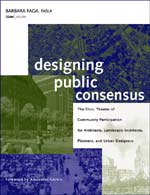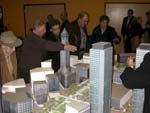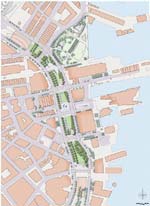
|
|
|
|
 |
|
Home Site Search Contact Us Subscribe
|
|
|
|
Designing Public Consensus: A Conversation with Barbara Faga, FASLA
Urban designer and executive vice president of EDAW discusses the trials, tribulations - and rewards of building public consensus. By Kenneth Caldwell June 12, 2007 Barbara Faga, FASLA, is an urban designer and executive vice president of EDAW, an international environmental practice. Her recent book, Designing Public Consensus, published by John Wiley & Sons, describes techniques for public participation using several case studies. Although it looks like a textbook, it doesn’t read like one. Each case study comes alive with her accessible and engaging narrative. Faga has accomplished something few else have tried: a readable guide through the city planning process. Although she is a principal in a large international planning firm, she has avoided writing a promotional tract; instead, she chose to reveal challenges, missteps, and even mistakes. This is not a coffee-table book. It’s a very human take on how cities get built.
We caught up with her recently at EDAW’s San Francisco office and asked her some questions about the book and her work.
Kenneth Caldwell: Why did you write this book?
Barbara Faga: We were involved in a very controversial project in Boston and we got into trouble. We had won a design competition to design the largest downtown parcel over the Big Dig underground highway. We were told that people had been meeting about this for 20 years and they didn’t want to meet anymore. They just wanted the park designed. Wrong.
Caldwell: How did you determine that the citizens were hostile?
Faga: There are always signs. One clear sign was that there were a lot of different factions representing many different interests and very mistrustful of each other. Then one day I got on the plane back to Atlanta and opened up my Boston Globe to read that we should be run out of town. That was the big sign.
Caldwell: Boston is a very involved city.
Faga: Bostonians are very experienced with the public process. But this was the only town I’d ever operated in where people introduced themselves by telling you where they went to high school. It’s very tribal. I’ve chaired commissions and been involved in hundreds of public meetings, and this was different. So when in doubt, take copious notes. I figured it would be valuable. It turned out to be the central case study for the book.
Caldwell: Because it was so different.
Faga: Yes. As a planner, I am always looking for comparables. I would sit in my hotel room in Boston, and I really couldn’t think of any comparables to what I was experiencing. So, I turned to other professionals I admire – Alex Garvin, Gary Hack, Fritz Steiner, Neisen Kasdin, Janet Gavarrette, Beth Dunlop – and asked their advice. In many ways my conversations with them became the basis for the book.
Caldwell: It looks like a textbook but that’s deceiving. The writing is much more personal, more accessible.
Faga: I wanted to make it like a conversation, almost like a public meeting. People want to hear stories. That’s how we share ourselves.
And I wanted a lot of voices in the book. I also thought it would be helpful for students in the design fields, so they could know what they're getting into. But I also wanted community groups to use it. It’s for everybody.
Caldwell: How would a community group use it?
Faga: In some situations a community needs to negotiate with a developer. One of the case studies discusses a situation where the community would not come to the table, and in the end they lost – they got nothing. Yet a community has a lot of power if they know how to wield it.
Caldwell: Some observers argue that the public process is sort of a crumb thrown to the public. The process allows the public to be heard, but in the end, developers and politicians still get their way.
Faga: I don’t agree with that. In a lot of communities where I have worked, the citizens can stop a project dead. When I started the book, I was more interested in testing whether the public process actually homogenizes a design. Does it lower the quality of design? Many landscape designers and architects say yes. But in the end, after speaking with the design professionals in depth and looking at all these case studies, I came to the conclusion that the public process helps design. Perhaps in the old days it was sort of a panacea. You know, “We'll put it up to the public, we'll see what they say, and then we'll do whatever we want.” That’s not true anymore.
I think it’s important, especially for designers, to leave behind a project that people feel they have something invested in it. It makes the project more successful.
Caldwell: Some landscape architects that I talk to feel that design professionals should establish the big moves and the public’s input is most useful – relating to this feeling of investment you mention – in the small moves, like the light standards and street furniture.
Faga: With landscape or park design, I think the public can have some effect on big moves once they begin to understand the design. For example, I have heard them say, "We don't use that entrance, we use this entrance.” And they tell you why people favor one entrance location over another. That can be a fairly big move in a park design. However, I would also agree that it is a designer's job to influence the actual design element or form. The public can help you set the stage, but in the end it's the designer who has to make this play actually work.
Caldwell: Are there moments you dread in the public process?
Faga: When people start talking about a carousel. When they can't think of anything else, they always want a carousel, and there are some places it works, and there are other places…
Caldwell: Why do they always want a carousel?
Faga: I don't know.
Caldwell: Maybe it's a nostalgic thread that runs through so many American childhoods.
Faga: It makes me crazy.
Caldwell: Let’s step back from the book for a minute – I think that people often feel that they're not heard in their lives, in their workplace, in the anonymity of urban and suburban life, and certainly in the overwhelming political deceit we experience. And someone goes to a public meeting about a park or a hospital expansion – they have to be heard. Even if they don’t have much influence, at least they have a moment where they are heard. And I think that's very powerful, very seductive.
Faga: It is powerful.
Caldwell: What's been the most rewarding public process that you've been through?
Faga: Probably Boston. It was the worst of times and the best of times. The presence of the freeway viaduct made it impossible to visualize ever building a park there. When the viaduct came down, however, people could actually visualize the opportunity and things calmed down. When I went to the groundbreaking, it was very rewarding.
Caldwell: Is there a core reason public processes work or don’t work?
Faga: You know you've got a decent public process if you can get decisions made. You just have to reach a decision and move on to the next event. Sometimes politicians conduct their own public process and they get in these loops where they can't make a decision. You can't just leave and say, "Okay, we're going to discuss this again."
Caldwell: How did writing the book change your perception about public consensus?
Faga: My point of view evolved. Participants will often tell you that parts of the consensus-building process are difficult, but that in the end there was a positive outcome. It’s important to remember that Moses is not going to show up and take us somewhere. Change will happen and you might as well figure out how to make it work to improve a project. I think I saw more angles, more points of view, and ways I can be more useful.
Caldwell: What about details?
Faga: Most people don't read plans and sections, and designers don't always understand this. Generally, the public prefers sketches and perspectives.
Caldwell: Technology has brought us all kinds of new tools.
Faga: Of course it depends on the age of the audience, but quite often they don’t want to see those. They want to see hand sketches, because that's what they're used to seeing. I was rather amazed by this thinking. Computer simulations are the newest, best thing, and wouldn’t you like to see that? Quite often they still want to see hand sketches. If I am working in a new community that I don't really know, I show different examples of sketches and techniques and find out which kind they understand best.
Caldwell: Is there one form of representation that most people understand or like best?
Faga: Models, but it’s hard to get the client to give you $50,000 for a model.
Caldwell: This underscores a key point, which is to know your audience. You've got to research your audience; you've got to start interacting with your audience, not necessarily around the controversial issues, but around just getting that baseline information so you know what you're dealing with. Can you talk about public consensus in other cultures?
Faga: You need familiarity with a local community wherever you work. Since I work for a large international firm, we often have offices near most of the communities where we work.
Caldwell: So there's some cultural sensitivity already present.
Faga: Yes, it’s critical. And it's got to be sensitivity to different age groups, too. I know some communities where they are not used to being asked their opinion. When we work in the Caribbean, we’ve heard, “No one's ever asked me what I want. Why are you asking me? Who are you going to tell these answers to?”
Caldwell: Have you had the experience of the members of the public having read your book and saying, “Now I read your book, Barbara, and I know what you're doing?”
Faga: Not exactly. It’s more like, “I read your book and is this situation like…” and they name a case study. Or sometimes, “Are you just building trust and then you're going to slap some design in front of us and expect us to go along with it?” I try to relate to the transparency aspect. I think everything has to be out there. I'm very suspicious of any process where there is not transparency. And so is the public.
Caldwell: So, it’s a positive if there is transparency on both sides.
Faga: Yes, but there are not necessarily only two sides – there may be several different perspectives. A city or a developer has to tell the public what their intentions are and what the limits are. You can't tell them something that’s not true. This is one of the advantages of the Internet – deceptions have a longer shelf life. In a wonderful way, the Internet has assisted this process in terms of exposing untruths but also in terms of welcoming more opinions and good ideas. I think the book’s presence is interesting right now because at this moment in our culture there's this great hunger for more transparency, for more honesty. I don't think any of this happens in a vacuum. It happens in political contexts that are larger than just the context of our project work. That’s the bigger point.
Kenneth Caldwell is a communications consultant and writer based in San Francisco. |
(click on pictures to enlarge)  (--) Designing Public Consensus (Wiley 2006), written By Barbara Faga, is a very human take on how cities get built (Courtesy of SMWM) The masterplan for Boston’s Rose Kennedy Greenway, which includes the Wharf District Park (©EDAW 2005. Photography by Dixi Carrillo) The freeway that had cut off downtown Boston from its waterfront since the 1950s made it difficult for the community to envision a park on that site (©2004 by Copley Wolff Design Group) Models, while expensive, are the best way of demonstrating the design to the public (©EDAW) The final design for the Boston Wharf District Park |
© 2007 ArchNewsNow.com